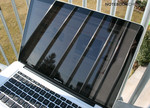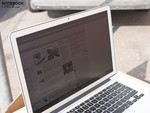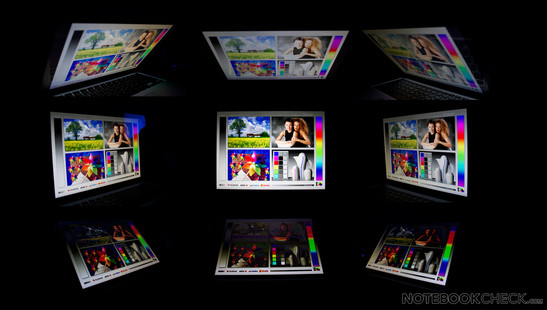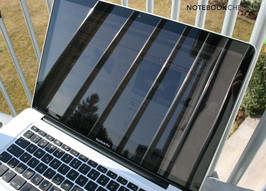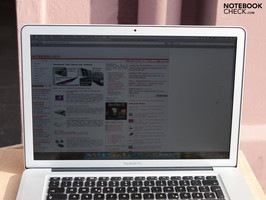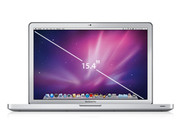Review Apple MacBook Pro 15 Early 2011 (2.0 GHz quad-core, glare-type screen)

Apple is currently offering the most recent MacBook Pro (Early 2011) with your choice of three different screens. For the starting price of 1749 Euro you get a WXGA display with a 1440x900 pixel resolution and edge-to-edge reflective screen (display frame also reflective). For an additional 100 Euro, the laptop comes with a sharper 1680x1050 pixel resolution. Professionals might prefer the version with WSXGA+ matte, non-reflective screen (review here), which costs 150 Euro on top of the starting price and is thoroughly discussed in the linked review.
In this review we take a close look at the most basic version of the MacBook Pro, which might be more appealing than higher-priced models since the starting price is already quite high.
Moreover, we've collected another set of scores for the benchmarks already performed on another MacBook Pro with identical hardware. We decided to subject this MBP to the same tests so as to possibly verify the issues associated with the Turbo Boost 2.0 function, the perhaps insufficiently large power supply as well as the CPU throttling we observed.
Display
We first take a look at the screen resolution here. It's interesting that Apple has once again chosen an aspect ratio of 16:10. This ratio offers a slightly "taller" picture compared to the very popular 16:9 wide-screen aspect ratio. With the 1440x900 resolution here, the user technically has approximately 24% more screen space compared to the nearly ubiquitous 15" HD resolution of 1366x768 pixels. The upgrade to the WSXGA+ version would mean an approximately 36% increase in work space and, therefore, would be particularly useful to professionals who use special software with numerous clickable icons like in photo or video editing. Full-HD (1920x1080) and WUXGA (1920x1200) screens remain unavailable for the Apple MacBook Pro 15. This can, of course, be a point of frustration considering the high price of these notebooks.
Now, it's time to get to the nitty gritty of the display at hand. Our test laptop's display model is "LP154WP4-TLA1". This display exhibits a maximum screen brightness of 260 cd/m², observed at the center of the screen. Compared to the WSXGA+ version (302 cd/m², matte) this amounts to a deficit of 42 cd/m² (14%).
In the lower corners of the screen, the brightness drops to under 200 cd/m², contributing to a brightness distribution of only 78%. With a minimum luminance of 277 cd/m², the WSXGA+ display is a great deal better in this respect: 92% brightness distribution.
| |||||||||||||||||||||||||
Brightness Distribution: 78 %
Center on Battery: 278 cd/m²
Contrast: 619:1 (Black: 0.42 cd/m²)
The lower screen brightness of the WXGA version is quite noticeable but still represents an improvement over the screens of most other 15" notebooks. The price-conscious Apple customer fortunately does not have cut back on quality in exchange for a lower price. The display of the starter laptop in review here shows an excellently low black level of 0.42 cd/m², allowing for a slighly better contrast ratio of 619:1 than the WSXGA+ display (581:1). Both values earn a rating of "Very Good" in our book and can only be topped by very few Windows laptops.
As far as the range of colors that can be displayed on the screen goes, we found this display to cover the sRGB color space quite well. This puts the MBP 15 Early 2011 on par with its predecessor from 2010. The MBP 15 (1680x1050 WSXGA+) with a sharper resolution still places at about the same level in terms of color space. Compared to a typical display, like in the HP Envy 15, we can see the superiority of the MacBook Pro's screen. Compared to a premium-grade screen, like in the Dell XPS 16 RGB, the MacBook Pro, however, does not even come close to covering the same color space.
For a long time matte screens on notebooks were the norm. Unfortunately, the tide shifted to ever-more-popular reflective screens that manufacturers claimed to have better contrast. However, now the excellent contrast ratios of both the matte and glossy-screened versions of the MacBook Pro 15 make this a non-issue in choosing which one to buy.
Next to the comfort of use in various surroundings (reflections strain the eyes), the biggest argument in favor of the matte screen is the potential to use the laptop outdoors and on the go. If you can't find an angle at which reflections don't completely eclipse the contents of the screen, on the train or in the office, these reflections might make use of the laptop practically impossible in the worst-case scenario. Only the combination of a matte screen and high display brightness can counteract the effect of direct sunlight or inconveniently placed light sources. The images below show the glossy WXGA+ display as well as the matte version of the WSXGA display under a clear sky in direct sunlight.
In terms of viewing angles, the TN display doesn't distinguish itself much from the overwhelming majority of laptop screens. Looking at the screen from an angle to the left or the right—aside from possible reflections—the picture remains undistorted even at sharper angles. On the other hand, when tilting the screen back and forth away from the ideal straight-forward viewing angle, the picture starts to become distorted at relatively small angles.
Performance
A comprehensive discussion of Apple MacBook Pro 15's performance—equipped with Intel Core i7-2635QM CPU and AMD HD 6490M graphics card—can be found here: Review of identical laptop with WSXGA+ glare-type display. The observed peculiar behavior during the stress test in Windows gives us reason to run some benchmarks once more in order to confirm or exclude the possibility of defects in the first laptop.
CPU Performance
We begin with CPU-intensive benchmarks. The Cinebench R10 benchmark (32bit), performed in Windows 7 (Bootcamp), yields a score of 3641 points in the single-core rendering test. This is nearly the exact same score as the matte version earned (3677 points). In the multi-core rendering test, we observed a score of 13581 points. This represents a slight improvement over the matte version's score (13045). A second trial of the multi-core test yielded a value of just over 13,000 points. The reason for this difference might be the Turbo Mode of the CPU, which does not always influence the score to the same extent. A fully cooled laptop can help Turbo Boost perform optimally, while built-up heat can mitigate the extent to which Turbo Boost increases performance in the early stages of a test.
In the Cinebench R11.5 test, our in-review laptop earns a CPU score of 4.68 points. The matte version earned an almost identical 4.6 points. The same is true for the OpenGL test, which resulted in the negligible difference between 22.18 and 22.07 points.
Verdict
Matte or glossy, this is the question for some considering the MacBook Pro 15. Even if this decision may come easy to professionals, weighing the options is still a smart idea since Apple is charging an extra 150 Euro for the version with a matte screen.
Two big considerations make us lean in favor of investing in the matte screen model: First, if you're planning to use the MacBook Pro for several hours every day, consider that glossy screens strain the eyes more. Second, using the laptop on the go, like on the train or bus—in which you're at the mercy of the changing light situation around you—might leave you frustratingly changing the viewing angle in hopes of avoiding reflections and seeing the screen contents better. What's the use of a good battery life when you can hardly recognize what's going on on the screen? If this sounds like your routine, it's best to go with the MacBook Pro 15 with a matte display and at the same time take advantage of a higher screen resolution.









